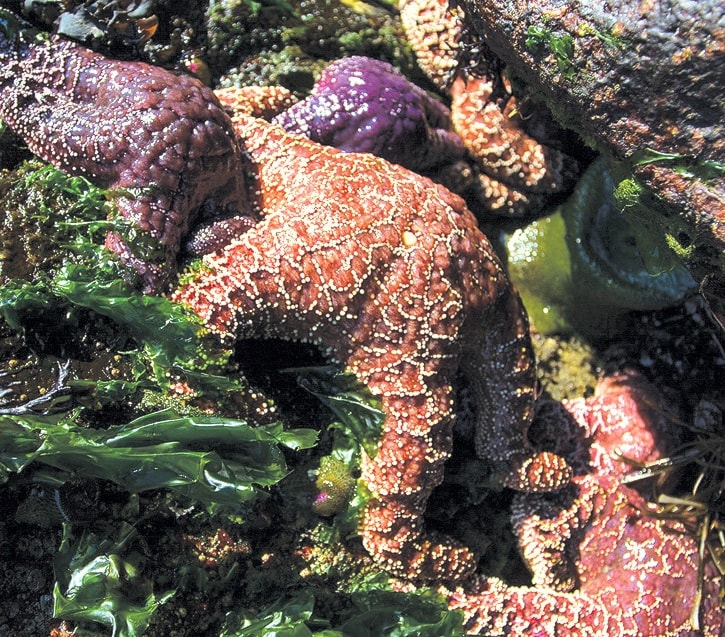The West Coast’s sea stars are under siege from a gruesome disease and a team of local scientists and volunteers are trying to get a handle on what’s going on.
The Strawberry Isle Marine Research Society is researching a rampaging bout of Sea Star Wasting Disease that is wreaking havoc on local sea star populations.
Jessica Edwards, the society’s research and administrative assistant, told the Westerly the disease
has brought mass die offs to as many as 20 different sea star species.
“Large die offs have been recorded before but never to this extent,” she said.
“The symptoms are pretty gruesome: lesions, loss of turgor, limb autotomy—self-amputation—and tissue degradation so severe it appears as if the star is melting.”
The project kicked off in June and Edwards said the society hopes to continue the work through a long-term intertidal monitoring project.
“So far we have engaged over 23 volunteers who have donated over 100 hours of their time and have measured over 1500 sea stars,” she said. “This time spent in the intertidal will help us become more familiar with the area, which will help us in the future with this ever changing climate to identify subtle changes in this important ecosystem.”
Any locals interested in joining the society’s army of volunteers can get on board the unique karma-boosting opportunity by emailing Edwards at jessica.edwards@strawberryisle.org
The society and its dedicated volunteers are monitoring four sites—near Tonquin Beach, Wickaninnish Beach, Strawberry Isle. and Ucluelet’s Whiskey Dock.
“When we arrive on site the group breaks up into smaller teams and the search begins,” Edwards said.
She said once a sea star is located, its species, size and health is recorded with health measured on a scale of 1-4, “where 0 indicates a healthy sea star and 4 is serious tissue degradation or death.”
Each site is visited monthly and each survey takes about two hours.
“We believe that this work is important locally to help researchers working on the spread and implications of this disease to better understand the big picture; and it is also important to be out there observing any changes that may be happening in the intertidal in our local waters,” Edwards said.
“We also believe that getting people outside learning about some of the issues that face our coast is incredibly important. Through projects like this that are largely driven by volunteers we can help to spread the conservation message and promote stewardship of this beautiful area that we live in.”
The project is being done in collaboration between the society and the Ucluelet Aquarium with partial funding coming from the World Wildlife Fund’s Go Wild Community Grant.
The society’s data collection is not yet complete so an exact number of local sea stars being affected is not yet known but Edwards said the disease has turned up at all four sites being monitored.
“The data that SIMRS is collecting will go towards a larger project that is run out of the University of California in Santa Cruz where they are using citizen science to map out the extent of the disease along the west coast of North America,” she said.
“This will help researchers in their quest to understand the disease and the impacts it will have on our coast. We also hope to engage the communities and visitors to the area by getting them out to volunteer or just sharing conversations about our work with them on their beach walk.”
She added that the research is important because sea stars are key players in the West Coast’s environment.
“This project is important to the society because the loss of such a prevalent predator on the coast will likely cause shifts within that ecosystem,” she said.
“For instance, the complete removal of ochre stars from a particular area would release the mussels from predation and that population could grow to a size such that it infringes on space and resources used by another organism. This top down effect could cause the ecosystem to shift. The most famous example of this happening on our coast is in the sea otter, kelp, and sea urchin system.”
andrew.bailey@westerlynews.ca
